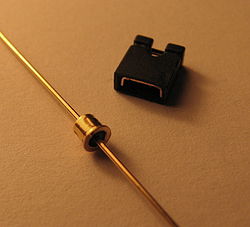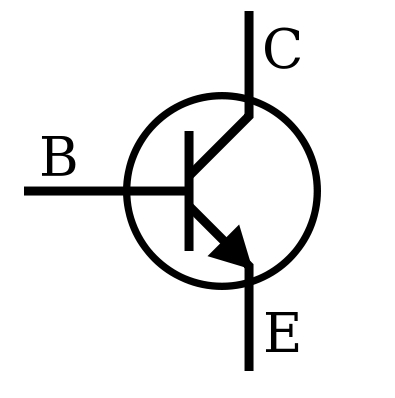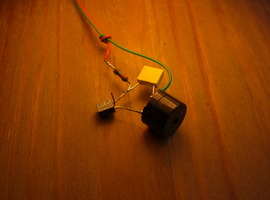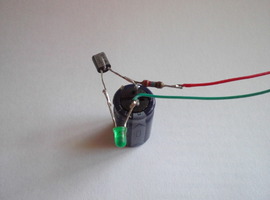Exploring Negative Resistance: Theory Meets Practice
| Polish version is here |
An Exotic Oscillator
Let’s start with a bit of theory:
The tunneling effect is a quantum mechanical phenomenon in which a particle passes through a potential barrier higher than the particle's energy. From the perspective of classical physics, this appears paradoxical, as the particle temporarily exists within a region forbidden by the classical conservation of energy principle.
In simpler terms, the tunneling effect allows a particle to pass through an obstacle that it shouldn’t be able to penetrate. This phenomenon is characteristic of the microscopic world and is described by the principles of quantum mechanics. There are two ways to explain it: through the wave function and Heisenberg's uncertainty principle. According to the wave function interpretation, the probability of detecting a particle on the other side of a barrier can exceed the probability of it existing before the barrier, resulting in what appears to an observer as an instantaneous jump through an impenetrable obstacle. The uncertainty principle, on the other hand, states that a particle energy can briefly increase beyond the barrier’s potential, allowing it to appear on the other side. In this interpretation, the event is not a physical penetration but rather a virtual jump over the obstacle. Although the jump itself is virtual, the particle’s presence beyond the barrier is entirely real.
That’s the theory. But can this phenomenon affect our daily lives? In the macroscopic world, such events seem impossible—people don’t randomly "tunnel" through walls. However, this is purely a matter of probability. For tunneling to occur visibly in an object, the effect would have to happen simultaneously and coherently across all its atoms. The likelihood of such an event is so minuscule that witnessing it spontaneously would take billions of years.
Yet, the tunneling effect plays a crucial role in our lives and the functioning of the universe. Nuclear fusion, which powers the Sun, occurs largely due to tunneling, allowing atomic nuclei to overcome the Coulomb barrier at lower temperatures than classical thermodynamics would predict. The tunneling effect also holds promise for lowering the temperature required for controlled fusion. Additionally, tunneling is responsible for alpha particle emission during the radioactive decay of heavy atomic nuclei.
In modern electronics, the tunneling effect is the foundation of many semiconductor components, such as tunnel diodes.
-“Oh!”—The beginner electronics enthusiast perks up.
-“A tunnel diode? What’s that?”
Allow me to explain. A tunnel diode, also known as an Esaki diode, is a semiconductor diode in which tunneling occurs when the junction is reverse-biased. This results in a region of negative dynamic resistance within a specific range of bias voltages, meaning that as the voltage across the diode increases, the current flowing through it decreases. The graph below illustrates this characteristic:

This characteristic is achieved in heavily doped junctions, where charge carriers can tunnel from the valence band to the conduction band both from the p-type to the n-type region and vice versa. The tunneling time is on the order of 10-13 seconds, enabling tunnel diodes to generate, amplify, and detect high-frequency oscillations (up to several hundred gigahertz), as well as serve as active components in pulse circuits (e.g., digital systems) and oscillators (thanks to their negative dynamic resistance). Below is a GE 1N3716 tunnel diode compared to a jumper wire:

However, tunnel diodes are relatively rare and can be expensive. Fortunately, electronics enthusiasts can explore quantum tunneling and negative dynamic resistance using readily available components.
DIY Tunnel Diode or "Negistor"
Let’s reach into the parts drawer for an NPN bipolar transistor. Take a look at its symbol:

Identify the three terminals: the collector (C), base (B), and emitter (E). It’s a well-known fact that the base-emitter and base-collector junctions can function as high-quality diodes:
- The B-C junction acts as a fast-switching diode with low reverse current (great for detection circuits).
- The B-E junction functions as a Zener diode.
But if we experiment further and test the E-C junction while leaving the base unconnected, we’ll discover that it doesn’t behave like a series combination of a Zener diode and a standard diode. This reversed connection is known as the "negistor" configuration, allowing the transistor to act as a makeshift tunnel diode.
From the earlier definition, we know that a negistor (acting as a tunnel diode) should be able to generate electrical oscillations. Let’s build a simple oscillator circuit to test this:

At first glance, this schematic might make any electronics enthusiast cringe: the transistor’s base is left floating, and the transistor is connected in reverse. However, this reversed connection allows the negistor to operate under the necessary reverse-bias conditions. The circuit works as follows:
- When power is applied, the capacitor begins to charge through the resistor, causing the voltage across it to rise.
- Once the capacitor’s voltage reaches a certain level, tunneling effects in the negistor come into play, resulting in negative dynamic resistance. The capacitor rapidly discharges through the negistor and the speaker.
- As the voltage across the capacitor drops below the threshold where negative resistance occurs, current flow through the negistor and speaker ceases. The capacitor then starts charging again, repeating the cycle.
With the given resistor and capacitor values, the speaker produces a high-pitched tone. If we replace the 100nF capacitor with a 2200µF capacitor and swap the speaker for an LED, the circuit becomes the simplest possible LED flasher. Note that this is essentially a relaxation oscillator that operates at much lower voltages than a traditional neon lamp oscillator (which also exhibits negative dynamic resistance under certain conditions). Below are photos of the circuits I assembled:
It's important to note that these improvised tunnel diodes typically require at least 8-10 volts to operate. The circuit will not work at lower voltages. Additionally, not all transistor models will exhibit this effect—you may need to experiment with different transistors to find one that works.
Enjoy experimenting with this fascinating phenomenon! :)
Further readings:
- Esaki L., Arakawa Y., Kitamura M., Esaki diode is still a radio star, half a century on, Nature, 2010, 464(7285), pp. 31
- Mathews P.T., Wstęp do mechaniki kwantowej, Państwowe Wydawnictwo Naukowe, Warszawa, 1977, pp. 61
- Phares R., The Mysterious "Negistor", A negative-resistance element, disguised as a transistor, with many udeful applications, Popular Electronics, 1975, 10, pp. 69-70
- Syrzycki A., Laboratorium elektrotechniki, Oficyna Wydawnicza Politechniki Warszawskiej, Warszawa, 1999, pp. 48
- Turner L.W., Electronics Engineer's Reference Book, 4th ed., Newnes-Butterworth, 1976, pp. 8-18
Marek Ples

